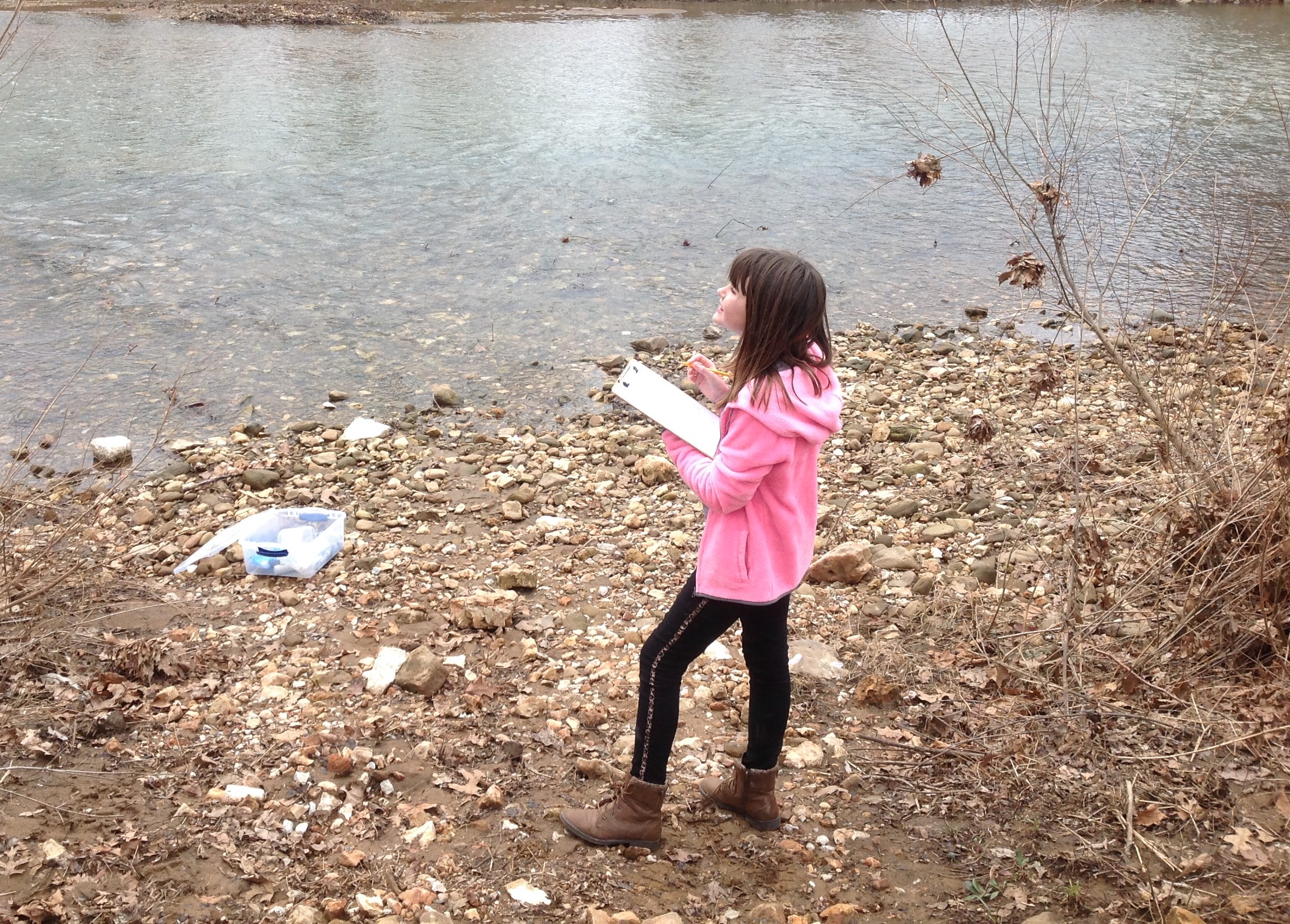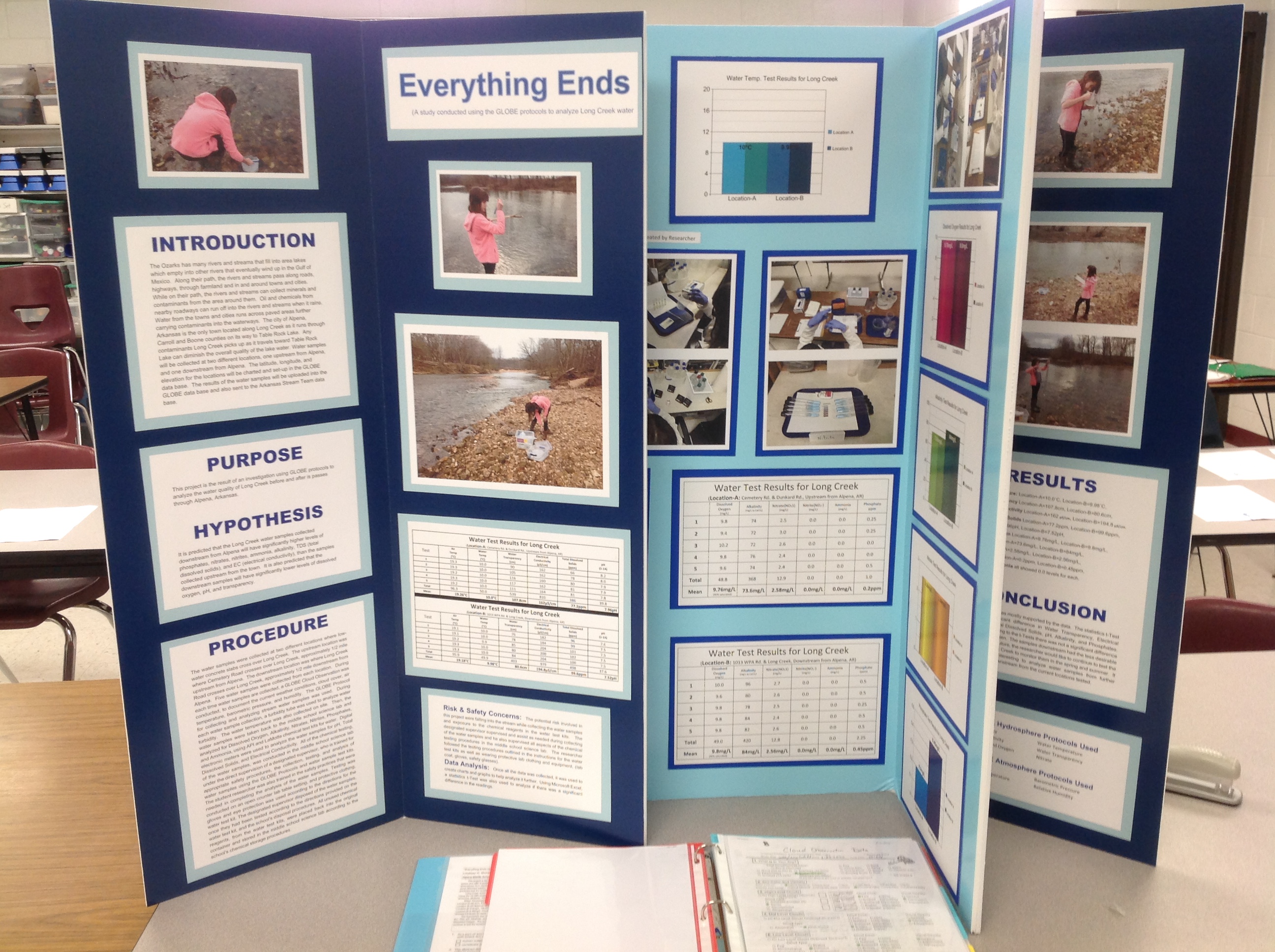RE: Everything Ends Up Downstream - Grade 6 - 2020 SRS - 2020 SRS
GLOBE Breadcrumb
- Home >
- 2020 SRS
Open social media sharing options menu
 Share
Share
GLOBE Side Navigation
Site Name
2020 Student Research Symposium (SRS)
Message Boards
- Home
- RE: Everything Ends Up Downstream - Grade 6
0
Project Title: Everything Ends Up Downstream - Grade 6
School Name: Alpena Elementary/Middle School
Teacher Name: Roger Rose
Student Name: Lindsay Dunsing
Grade Level: 6
Project Description: A study conducted using the GLOBE protocols to analyze Long Creek water samples collected from upstream and downstream of Alpena, Arkansas.
Abstract: This project is the result of an investigation using GLOBE protocols to analyze the water quality of Long Creek before and after is passes through Alpena, Arkansas. It is predicted that the Long Creek water samples collected downstream from Alpena will have significantly higher levels of phosphates, nitrates, nitrites, ammonia, alkalinity, TDS (total dissolved solids), and EC (electrical conductivity), than the samples collected upstream from the town. It is also predicted that the downstream samples will have significantly lower levels of dissolved oxygen, pH, and transparency.
Long Creek water samples were collected at two similar locations upstream and downstream from Alpena, AR. Using the GLOBE protocols for Integrated Hydrology, samples were tested for temperature, phosphates, nitrates, nitrites, ammonia, alkalinity, TDS, EC, dissolved oxygen, pH, and transparency. 5 tests were conducted for each location.
Water Temperature: Location-A=10.0˚C, Location-B=9.98˚C, Water Transparency: Location-A=107.8cm, Location-B=80.6cm, EC: Location-A=162 µS/cm, Location-B=194.8 µS/cm, TDS: Location-A=77.2ppm, Location-B=99.6ppm,pH Location-A=7.96pH, Location-B=7.52pH, Dissolved Oxygen: Location-A=9.76mg/L, Location-B=9.8mg/L, Alkalinity: Location-A=73.6mg/L, Location-B=84mg/L, Nitrate: Location-A=2.58mg/L, Location-B=2.56mg/L, Phosphate: Location-A=0.2ppm, Location-B=0.45ppm, All of the tests for Nitrite and Ammonia showed 0.0 levels for each.
The hypothesis was mostly supported. The statistics t-Test showed a significant difference in Water Transparency, EC, TDS, pH, Alkalinity, and Phosphates. However, according to the t-Tests there was not a significant difference in Dissolved Oxygen. The samples downstream had the less desirable readings. In the future, the researcher would like to continue to test the locations for Long Creek to monitor them in the spring, summer, fall and adding more locations.
Atmosphere Protocols: Hydrosphere Protocols: Turbidity, pH, Water Temp. Dissolved Oxygen, Nitrates, Electrical Conductivity, Alkalinity; Atmosphere Protocols: Air Temp, Barometric Pressure, Clouds, Relative Humidity
Language: English
Video URL: https://youtu.be/4N2jK0m3Vnw

![]()

![]()
School Name: Alpena Elementary/Middle School
Teacher Name: Roger Rose
Student Name: Lindsay Dunsing
Grade Level: 6
Project Description: A study conducted using the GLOBE protocols to analyze Long Creek water samples collected from upstream and downstream of Alpena, Arkansas.
Abstract: This project is the result of an investigation using GLOBE protocols to analyze the water quality of Long Creek before and after is passes through Alpena, Arkansas. It is predicted that the Long Creek water samples collected downstream from Alpena will have significantly higher levels of phosphates, nitrates, nitrites, ammonia, alkalinity, TDS (total dissolved solids), and EC (electrical conductivity), than the samples collected upstream from the town. It is also predicted that the downstream samples will have significantly lower levels of dissolved oxygen, pH, and transparency.
Long Creek water samples were collected at two similar locations upstream and downstream from Alpena, AR. Using the GLOBE protocols for Integrated Hydrology, samples were tested for temperature, phosphates, nitrates, nitrites, ammonia, alkalinity, TDS, EC, dissolved oxygen, pH, and transparency. 5 tests were conducted for each location.
Water Temperature: Location-A=10.0˚C, Location-B=9.98˚C, Water Transparency: Location-A=107.8cm, Location-B=80.6cm, EC: Location-A=162 µS/cm, Location-B=194.8 µS/cm, TDS: Location-A=77.2ppm, Location-B=99.6ppm,pH Location-A=7.96pH, Location-B=7.52pH, Dissolved Oxygen: Location-A=9.76mg/L, Location-B=9.8mg/L, Alkalinity: Location-A=73.6mg/L, Location-B=84mg/L, Nitrate: Location-A=2.58mg/L, Location-B=2.56mg/L, Phosphate: Location-A=0.2ppm, Location-B=0.45ppm, All of the tests for Nitrite and Ammonia showed 0.0 levels for each.
The hypothesis was mostly supported. The statistics t-Test showed a significant difference in Water Transparency, EC, TDS, pH, Alkalinity, and Phosphates. However, according to the t-Tests there was not a significant difference in Dissolved Oxygen. The samples downstream had the less desirable readings. In the future, the researcher would like to continue to test the locations for Long Creek to monitor them in the spring, summer, fall and adding more locations.
Atmosphere Protocols: Hydrosphere Protocols: Turbidity, pH, Water Temp. Dissolved Oxygen, Nitrates, Electrical Conductivity, Alkalinity; Atmosphere Protocols: Air Temp, Barometric Pressure, Clouds, Relative Humidity
Language: English
Video URL: https://youtu.be/4N2jK0m3Vnw


0
From Dr. Dixon Butler (https://www.globe.gov/web/dixon.butler): What a wonderful project. You did considerable work to effectively test your hypothesis. Did you stabilize the DO concentration in the field before taking the samples to the lab? What activities in your town led to the changes you observed? I hope you will expand your project with more observations, taken in different seasons.
0
Hello Lindsay, I am a geologist at the Arkansas Geological Survey and enjoy seeing the project in Arkansas. I think your project was very well done! Your graphs were easily understood and your text flowed nicely. This is a great opportunity to open up a discussion about our environment and especially locally in your own community, so well done. I like your suggestions about following up throughout the seasons because that is very important to explaining changes in results. I noticed your phosphate levels doubled at the downstream location. For future studies, I would recommend defining the reasons you might have changes in phosphate levels and total dissolved solids. Follow up with collecting a sample to see what your solids are in the water and go from there. Or try to figure out where the phosphate is coming from. Is it from the rocks? Or from farming or waste water? Excellent job!
0
Hi Lindsay! My name is John Farver and I am a Geology Professor at Bowling Green State University who has done alot of research regarding water quality. Your project was really well done and I especially appreciated your video down at the stream showing how you made some of your measurements. I think your idea to extend the study to different times of the year, and especially different flow conditions, is a really good one. Things you might want to think about going forward are how large is Alpena, what types of industry might contribute to the stream and especially where were your sample sites relative to things like wastewater treatment facilities (sources of nutrients). I bit of a nitpicky comment is it would be nice if you reported uncertainties on your numbers (like a 2-sigma standard deviation) and for the nitrite and ammonia values what you really mean is that they were below the detection limits of your method (not 0.0). I thought the graphs for your poster were well done and showed the results very well. Again, great job and I hope you continue with this type of research.










